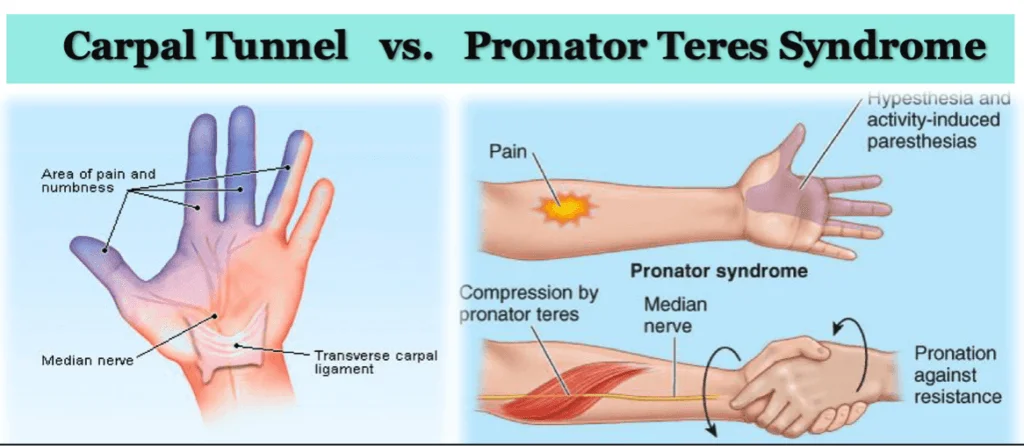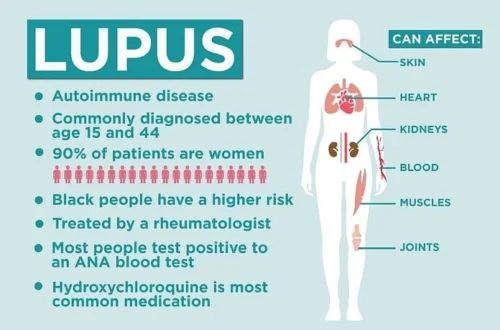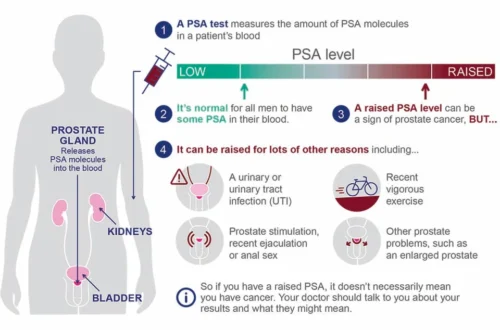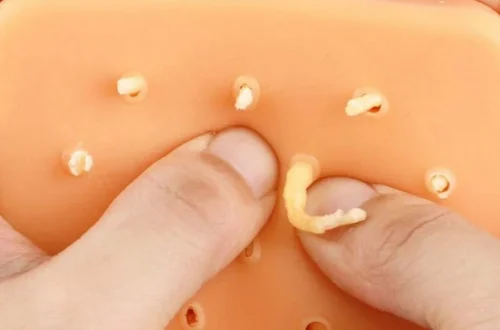Two Conditions That are Often Misdiagnosed as Carpal Tunnel Syndrome: Carpal tunnel syndrome (CTS) is among the most recognized causes of hand and wrist pain, numbness, or tingling. However, because its symptoms overlap with many other disorders, misdiagnosis is a real and important risk. In clinical practice, two conditions frequently mistaken for CTS are cervical radiculopathy and wrist tendinitis / tendonitis.
These conditions can mimic the sensations of CTS but require very different treatments. Misdiagnosis can delay effective care, or even lead to unnecessary surgery. This article explains how to recognize these mimics, how they differ, and what to watch for.
Cervical Radiculopathy: A “Neck Problem” Masquerading as Wrist Pain
Cervical radiculopathy occurs when a nerve root in the neck (cervical spine) becomes compressed or irritated—often by a herniated disc, osteoarthritis, or foraminal narrowing. That nerve irritation can refer pain, numbness, or tingling down the arm, affecting the wrist and hand in ways that mimic CTS.
How It Overlaps with Carpal Tunnel Syndrome
- Patients may report numbness, tingling, or burning sensations in the hand or fingers, often overlapping with the distribution of the median nerve (thumb, index, middle)
- There may also be arm pain, neck pain, or scapular discomfort—features generally absent in isolated CTS
- Symptoms often worsen with neck movement (e.g. bending or twisting neck), which is a clue toward a cervical origin
- Some cases of failed CTS surgery, upon later evaluation, were found to be cervical in origin rather than true median nerve compression at the wrist
Key Clues Differentiating It
| Feature | Cervical Radiculopathy | Carpal Tunnel Syndrome |
|---|---|---|
| Neck symptoms | Often present (neck pain, stiffness, radicular pain) | Usually absent or minimal |
| Provocative maneuvers | Spurling’s test, neck extension / rotation worsen symptoms | Phalen’s maneuver, wrist flexion, Tinel’s at wrist |
| Distribution | May extend beyond median nerve territory, may follow dermatomal pattern | Confined to median nerve distribution (thumb, index, middle, radial half of ring) |
| Electrodiagnostic studies | Can show nerve root involvement or multilevel changes | Abnormal median nerve conduction across the carpal tunnel |
| Treatment | Cervical traction, physical therapy, possibly surgery on spine | Wrist splints, corticosteroids, carpal tunnel release, etc. |
Mistaking cervical radiculopathy for CTS can lead to surgeries at the wrist that do nothing to relieve the root cause. Correct diagnosis calls for imaging (MRI, CT), physical exam of the neck, and electromyography / nerve conduction studies that distinguish root from distal compression.
Wrist Tendinitis / Tendonitis: Inflammatory Pain Often Confused with Nerve Pain
Tendinitis (or tendonitis) is inflammation of tendons—commonly those in the wrist and forearm. Often from repetitive stress, overuse, or microtrauma, it produces pain, swelling, and functional limitation—but because the wrist is involved, it can mimic CTS.
For instance, de Quervain’s tenosynovitis, affecting tendons on the thumb side of the wrist, can cause pain radiating toward the fingers that might be confused with CTS.
Why Tendinitis Gets Misdiagnosed
- Pain and discomfort in the wrist and hand areas overlap—with or without numbness
- Swelling or tenderness may be misinterpreted as nerve compression
- Overuse patterns (e.g. keyboarding, texting, repetitive wrist motion) are common to both conditions
Distinguishing Factors / Clues
- Localized tenderness over a tendon rather than diffuse numbness
- Pain with movement or loading (flexion/extension) rather than primarily at night or with wrist flexion
- Lack of true numbness or sensory changes — tendinitis usually causes pain, not nerve symptoms
- Absence of electrodiagnostic abnormalities in median nerve
- Response to local treatments: rest, NSAIDs, splinting the tendon (not nerve decompression) often resolves the symptoms
If tendinitis is mistaken for CTS, a patient may undergo unnecessary nerve release, which would not address the inflammation in the tendon. Accurate diagnosis demands careful physical exam—palpation, movement tests, and possibly ultrasound of the tendon sheaths.
Why Misdiagnoses Happen: Diagnostic Pitfalls & Red Flags
There are several reasons CTS is overdiagnosed (or mimics are underrecognized). Recognizing these pitfalls is essential.
Symptom Overlap & Common Uses of the Hand
Many people use their hands repetitively—typing, texting, tools, etc. That predisposes both tendinous stress and nerve compression, making symptoms blur together.
Reliance on Clinical Symptoms Alone
Signs like nocturnal tingling, hand weakness, or “shaking hands” are classically associated with CTS—but those same signs can also appear in radiculopathy or polyneuropathy. Clinical features alone are insufficient.
Limitations & Errors in Electrophysiological Testing
Electromyography (EMG) and nerve conduction studies (NCS) are standard aids—but they can have false negatives and false positives. If interpretation is flawed, a mimic may be accepted as CTS.
In the literature, some patients presumed to have CTS (and even treated surgically) later turned out to have other neurologic diseases.
“Double Crush” Phenomenon
Sometimes nerve dysfunction occurs at more than one level (e.g. cervical root + carpal tunnel). In such cases, releasing only the wrist compression may not alleviate all symptoms, leading to the perception of misdiagnosis.
Atypical Presentations & Red Flags
Red flags such as symptoms beyond the median nerve distribution, unstageable or progressive neurologic signs (e.g. myelopathy), or failure of expected treatments should prompt reconsideration of diagnosis.
Clinical Approach: How to Avoid the Mistake
When you suspect CTS, here’s a guiding framework to distinguish true CTS from mimics like radiculopathy or tendinitis:
1. Comprehensive History & Symptom Mapping
Map where symptoms are felt: are they purely in the hand, or do they ascend toward shoulder or neck? When do they worsen—night, movement, posture changes?
2. Physical Examination
- Neck / Spurling’s test for radiculopathy
- Tinel’s, Phalen’s, Durkan’s test for median nerve compression
- Provocative tests for tendonitis: resistive movements, palpation over tendon sheaths
- Evaluate joint / bony changes for arthritis (though not our main focus here)
3. Electrodiagnostic Testing
Use EMG / NCS to measure median nerve conduction across wrist. But interpret cautiously—false results are possible. Add testing to exclude radiculopathy or polyneuropathy.
4. Imaging & Additional Studies
- MRI or CT of cervical spine if radiculopathy suspected
- Ultrasound of wrist tendons to detect tenosynovitis or tendon thickening
- X-rays for bone / joint disorders
5. Monitor Response to Treatment
If wrist decompression or splinting fails or gives incomplete relief, re-evaluate and consider alternative diagnoses.
6. Multidisciplinary Approach
Referrals to neurology, hand specialists, or physiatrists can help refine the diagnosis when complexity exists.
Conclusion: Awareness Saves Patients Time & Unnecessary Procedures
While carpal tunnel syndrome is a common cause of hand pain, cervical radiculopathy and wrist tendinitis easily mimic its symptoms. Misdiagnosing them as CTS can lead to ineffective or even harmful treatments.
By paying close attention to symptom distribution, provocative signs, and careful use of diagnostic tools, physicians and patients can avoid the costly trap of misdiagnosis. If your hand or wrist symptoms do not respond to standard CTS treatment, it’s wise to ask your provider whether a different condition might be responsible. Early recognition means more accurate intervention—and less wasted time and suffering.





